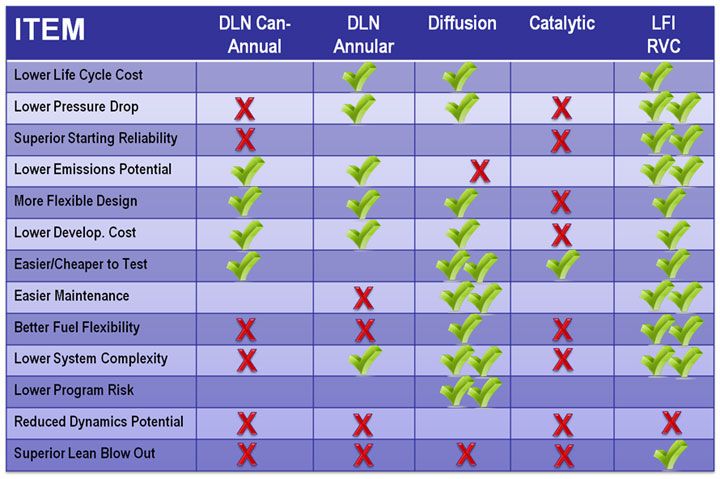Technology: Clean Gas Turbine CombustionDisruptive Ultra Low Emissions Combustion Technology
The increasingly detrimental effects of combustion exhaust emissions on the environment have necessitated swift implementation of strategies to reduce their levels to limits unimagined before. Washington DC based Lean Flame Inc. has developed an innovative and disruptive technology which achieves such emissions targets but which also has the ability of lowering the bar further. The technology is referred to as the Recirculating Vortex Combustor® (RVC®).
The Recirculating Vortex Combustor® (RVC®) promotes the oxidation of very lean fuel-air mixtures while yielding extremely high combustion intensities. This is achieved through creation of a recirculating source of hot combustion products that are isolated from the main flow and therefore resistant to external flow-field perturbations. The net effect is a system operating near 100 percent combustion efficiency while simultaneously achieving ultra low emissions levels (NOx, CO, UHC < 3ppmdv @ 15% O2) in a highly compact form. The novel design concept departs radically from conventional swirl or bluff body stabilized combustors that have been used for decades. Its simplistic yet robust design has many other key attributes including the following:
- Applications: Gas Turbines (land based, aircraft (main engine and APU's) commerical, military)
- Multi Fuel Capable: Gas, Liquid, Low BTU, Synthesis Gas, Hydrogen, "dirty" fuels, etc.
- Provides a 0.5-1.0% increase in overall Cycle Efficiency relative to Dry Low Emissions Technologies (DLE) used in current Gas Turbine applications
- Provides over a 50% reduction in Combustion System Pressure drop relative to DLE strategies for increased cycle efficiency and reduced fuel burn (improved fuel economy/savings of 1%) which increases simple cycle efficiency by 1 to 1.5%
- Ultra low NOx, CO and UHC (< 3ppmdv @ 15% O2) - natural gas, virtually zero particulates
- Ultra Low, Lean Blowout Limits, (LBO fuel-air ratios < 0.003) for greater engine operability
- Overall Lean Blow Out fuel-air ratios down to 0.0015 (see LFI UTRC results, 2009)
- Flatter Exit Combustor Temperature profile for improved turbine life
- Compact burner for reduced size, weight and cost relative to current technologies
- Simpler design, reduced maintenance cost (few parts) and increased system life over current technologies
- 50% improvement in ignition, high altitude relight and blow out over current technologies (aerospace applications)
- Increased combustion intensity for Reduced PM/CO
- Five times the turn down of conventional combustors with ultra low NOx and CO emissions from 50% to 100% load
- Superior Operability Envelope (w.r.t. fuel type, flame speed variability, throughput velocity, turndown, operating pressure, etc.) - 40% wider than conventional combustors (source: AIAA 2001-0483)
- Reduced Size and Lower Weight - key to aerospace applications
- Combustion Efficiencies, even at high inlet velocities (M~ 0.7), >> 99% (see LFI UTRC results, 2009 and AFRL/NASA Presentation, 2009)
- Superior EGT Profile and Pattern Factor (source Roquemore et al., AFRL/NASA presentation, 2009)
- Operates well in many combustion modes: diffusion, lean premixed and/or RQL

Lean Flame Inc. has successfully demonstrated their product on actual small scale gas turbine (150kWe) running on both liquid and gaseous fuels and on a large scale (1.5MWe) turbine running on natural gas and pressures around 150psia and combustor inlet temperature in excess of 600F.
|
|